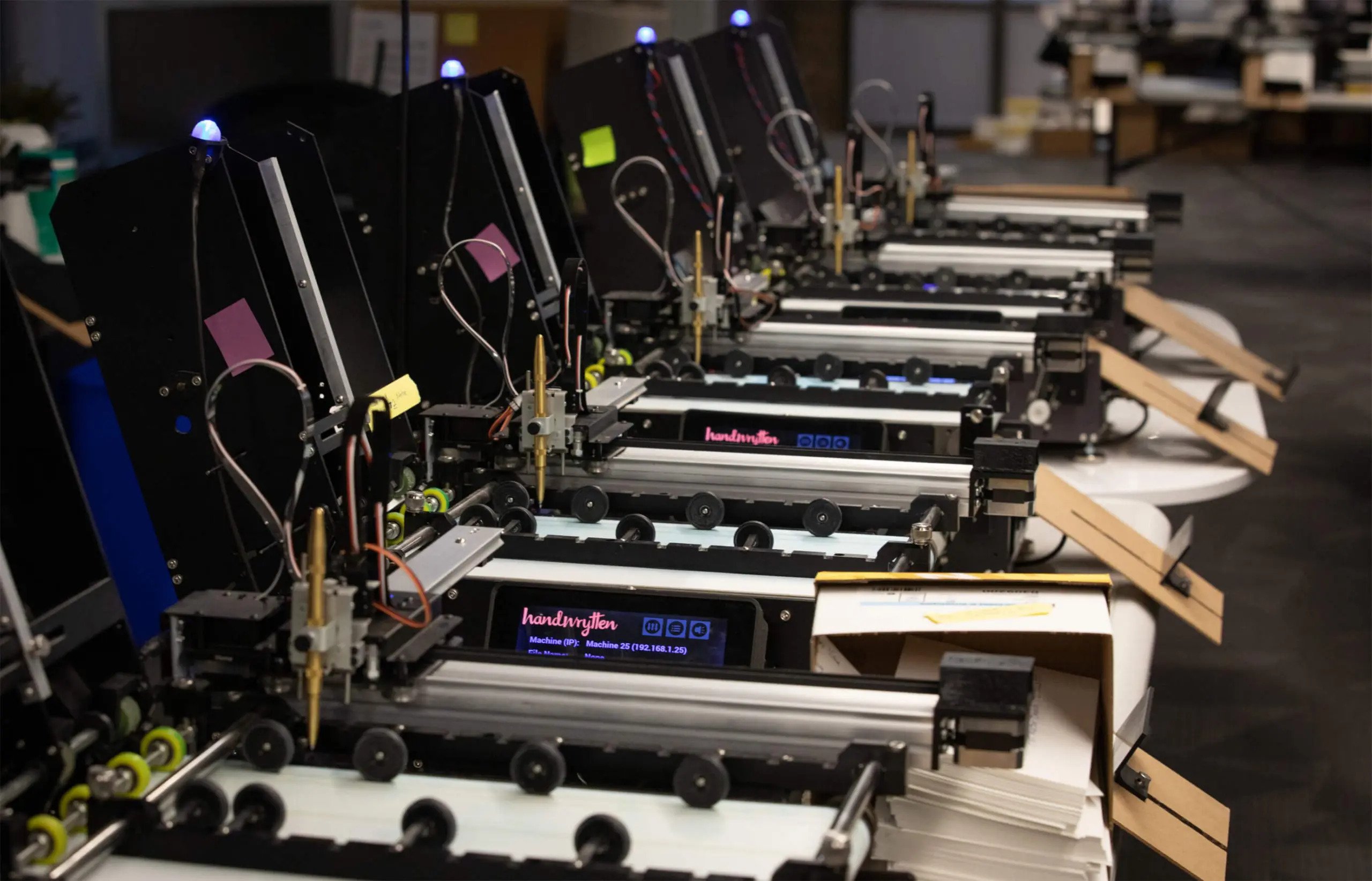 EMERGING TECH
EMERGING TECH
 EMERGING TECH
EMERGING TECH
 EMERGING TECH
EMERGING TECH
In a world of pre-sorted, data-driven, machine-generated messages, handwritten notes have become as odd as the rotary telephone. CBS News reported in 2021 that 37% of Americans hadn’t sent a handwritten letter in over five years and half hadn’t received one.
The rarity of pen-and-ink messages makes them compelling enough that they usually get read. A study by the Direct Marketing Association a few years back found that 99% of handwritten letters are opened compared with less than 10% of machine-generated mail.
That makes sending pen-and-ink messages a pretty attractive option for marketers, which is what David Wachs is betting on. Nine years ago, he founded Handwrytten Inc. to automate the art of note-writing at large scale.
Today the company’s 175 robots spend their time churning out notes in one of 35 different off-the-shelf styles. Handwrytten can also create custom styles based on a person’s handwriting for prices starting at $1,000.
The self-funded company turns out thousands of messages each day, most of them scrawled on one of an assortment of 4.25-inch-by-5.5-inch folded or five-inch-by-seven-inch flat note cards and inserted into a hand-addressed envelope. Pricing starts at $3.25 each, but the sweet spot of the market for Handwrytten is the marketers, automobile dealers and real estate firms that send 100 or more cards a month.

Handwrytten robots introduce enough imperfection into their printed output to simulate handwriting. Image: Handwrytten
There’s nothing new about automated handwriting. The first autopen was patented in 1803 and descendants of that primitive early device are still widely used today for signing documents and autographs. Handwrytten started out using off-the-shelf autopens but soon realized that the results looked too much like they had been generated by a machine. It switched to robots of its own design that use machine vision to make the output look more human-like (pictured, adjacent).
“We bought a conveyor belt and programmed it with a robotic arm,” Wachs said. “We laser-cut and 3D print circuit boards. It’s completely vertically integrated.” Manufacturing spans the entire process from feeding blank paper into digital presses for preprinting to addressing, stamping and sealing the finished envelopes.
“We can control the software, the variability of writing and ligature combinations,” Wachs said. “Because we own the tech stack, we have full control over variability and quality.”
The output isn’t always pretty, but that’s the point. Most people’s handwriting is less than perfect and Handwrytten’s algorithms attempt to inject just enough messiness to make the robotic output look real.
“We alternate characters so no two look alike and we vary line spacing and the edge,” Wachs said. “It looks like you tried to write straight across the page but had a hard time doing it.”
Handwrytten integrates with a number of customer relationship management, direct mail and process automation applications and also publishes an interface that can be used to connect to hundreds of other applications. Early this year the company added automated note generation powered by OpenAI LP’s ChatGPT.

Handwrytten’s Wachs: “Because we own the tech stacks we have full control over variability and quality.” Photo: David Wachs
Wachs (pictured, adjacent) estimated Handwrytten has about 15,000 active clients. Although most use the service for a few cards a month, some department stores and luxury brands send up to 80,000 cards a year, he said. The service is especially popular with car dealers, realtors, mortgage brokers and nonprofits. None want to be named for fear that their tactics could be considered deceptive.
Wachs said some have reported impressive results. One car dealer switched from print to handwritten notes and said it saw a 27-fold increase in response rate. A bespoke suit maker reported a 16% coupon redemption rate when sent with a handwritten offer.
A snack box company uses the service to win back customers whose orders were misdelivered or damaged. “If they screw up, they follow up with a replacement box and a thank-you note,” Wachs said. “They found that clients who get the win-back offer order more than clients who were never the victim of a mistake in the first place.”
Handwrytten isn’t alone in the market. Competitors include Handwrite, Felt LLC, RoboQuill, Simply Noted, Audience, Addressable and Pen Letters. Some have raised venture capital, but Wachs said he prefers the control of a bootstrapped business. It forces him to rely on innovation to compete, and he ticks off a list of plans.
“We have a new offering that sends a birthday card each year,” he said. “We’re coming out with a multistep management system for drip campaigns. And we’re going to add QR codes and multiple robot locations in the future. As we scale, it creates too much risk to have all our eggs in one nest.”
Support our mission to keep content open and free by engaging with theCUBE community. Join theCUBE’s Alumni Trust Network, where technology leaders connect, share intelligence and create opportunities.
Founded by tech visionaries John Furrier and Dave Vellante, SiliconANGLE Media has built a dynamic ecosystem of industry-leading digital media brands that reach 15+ million elite tech professionals. Our new proprietary theCUBE AI Video Cloud is breaking ground in audience interaction, leveraging theCUBEai.com neural network to help technology companies make data-driven decisions and stay at the forefront of industry conversations.